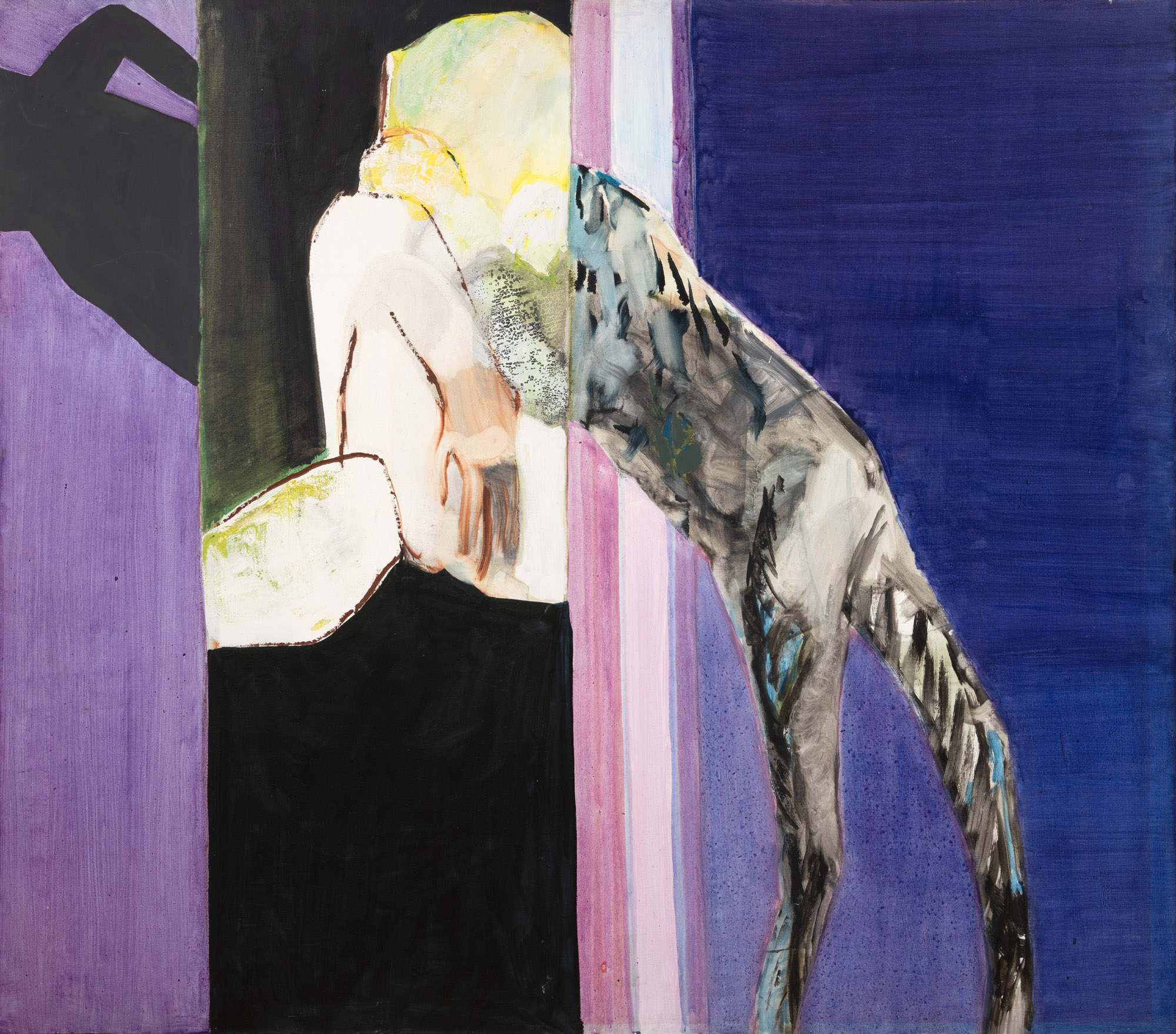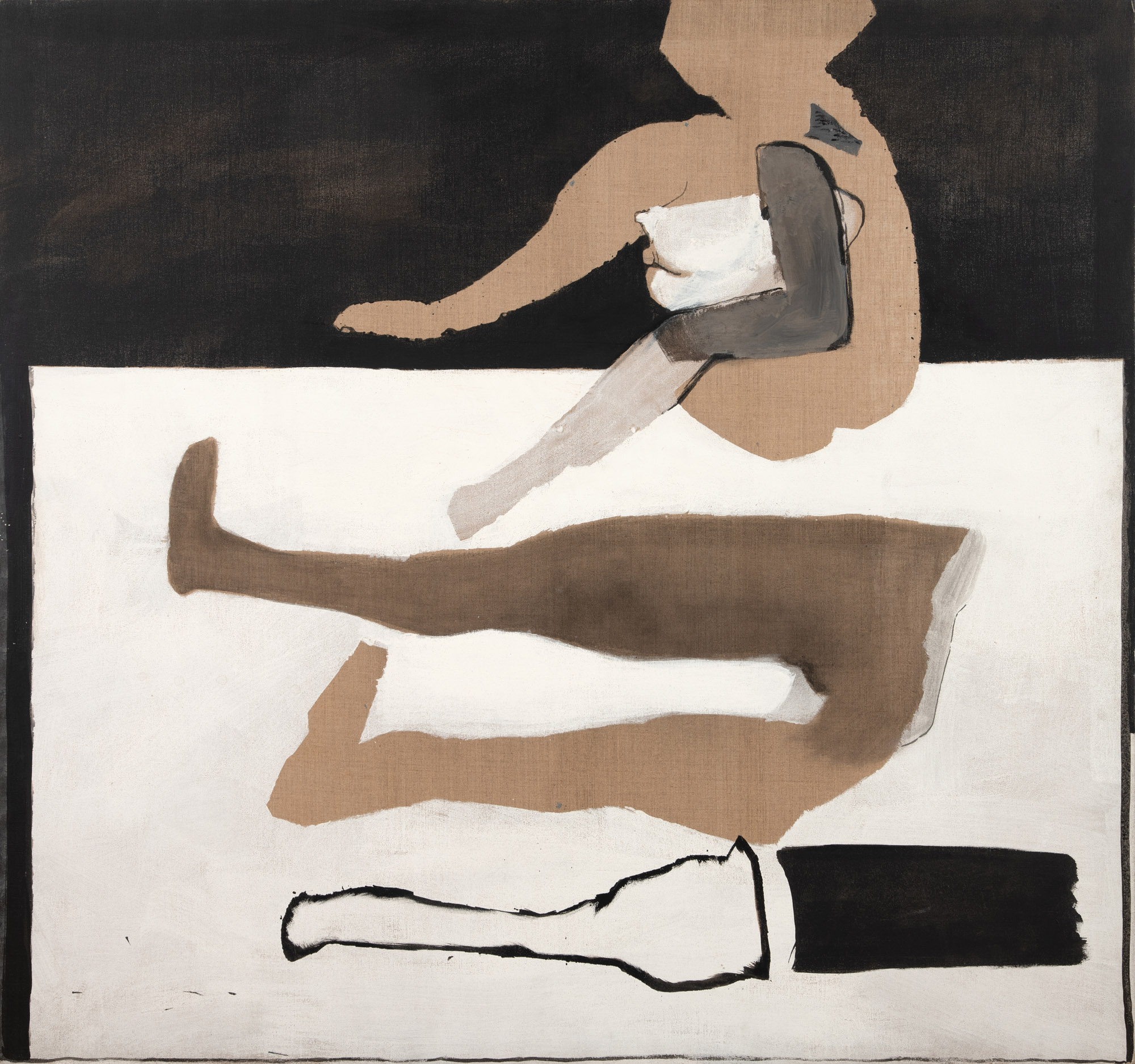Artists: Zuza Golińska & Teresa Pągowska
Exhibition title: Betwixt #2
Venue: Piktogram, Warsaw, Poland
Date: July 9 – August 27, 2022
Photography: all images copyright and courtesy of the artist and Piktogram, Warsaw
Betwixt is a place that requires two separate points of reference to be created. These points can be people or objects. When they are put together, a kind of axis is built. Separate points on the map are quickly joined with a thread that is invisible to the eye. This line can tighten and relax in a controlled way depending on how close or far they are from each other. The bodies that clash with one another create tension – the relationship space. In between, everything becomes blurry. It’s hard to tell which is one and which is the other. Together, they create an open room that everyone has access to. Its space shrinks or expands depending on how many guests stay in it. We can find many similar networks of this kind around us. Together, they all create an ongoing project of a house where everyone has a corner of their own. The stories of individual rooms mesh and overlap on top of each other. They create a ground for us to walk on. Each of us become coordinates, points of reference on a map that measures this abstract space. The distance from her to her is the same as from me to you. From guests, we turn to hosts. The moment we change our role is instant. The length of this second changes depending on the time we become aware of what the betwixt is.
by Ant Łakomsk
Betwixt #2 is the continuation of a project of which the first edition took place over 3 years ago and consisted of works from artists of different generations, Wanda Czełkowska and Paul Czerlitzki.
*
Zuza Golińska is a multidisciplinary artist who explores the seemingly binary relationship between modernism and contemporary romanticism, between discipline and magical thinking. She analyses the events from her life in a broader socio-political context, noting the patterns of which she is a part of. Zuza is interested in the heritage of the former Eastern Bloc in the construction of her own cultural and gender identity. In her work she explores the impact of space and architecture on human beings. She analyses the relationship between an organized structure and the body. The public and the private sphere. Using different means, Zuza tries to build new models of shared spaces. She wonders what it means to be together and to what extent this is possible nowadays. Is it possible to create a community through a properly constructed space?
She consciously refers to familiar functional forms or architectural models, which she then deconstructs. Through her projects, Zuza tries to build new, less hierarchical relationships with people and the environment.
The key to Teresa Pągowska’s work is (as art theoreticians had written) the human figure. The artist was associated with the international New Figuration movement. Even though everything seems to be right: the silhouette, expression, subjectivism or deformation, the term “figure” has multiple meanings that seem to drift away from the human body itself – a figure is in fact devoid of a body, it’s simply a shape on a surface, an idea of human physique. Therefore we need to look not at the figure in Pągowska’s paintings but at the body because it dominates in her work. Through it she wants to convey something special to us. It is not just some abstract body, it’s a woman’s body.
“My painting becomes my image and its strength becomes my strength,” said Pągowska, emphasizing the integrity of her work and her artistic focus.
In Pągowska’s paintings subjected to the highest notion of work discipline and constant simplification, one feels very directly the anxiety, tension and strong emotional charge creating an unclear situation that’s happening or is about to happen.
*
Zuza Golińska (born in 1990 in Gdańsk) lives and works in Warsaw, Poland. A graduate of the Studio of Spatial Activities at the Academy of Fine Arts in Warsaw. She wrote her master’s thesis under the supervision of Anda Rottenberg. In 2015, she was nominated for the StartPoint Prize. In 2018, she won the ArtePrize awarded by the ArteVue and Delfina Foundation and is one of the winners of Dorothea von Stetten Art Award 2022. Her works have been shown, among others in: Museum of Modern Art in Warsaw, Zachęta National Art Gallery in Warsaw, Delfina Foundation in London, National Museum in Prague, Yokohama Triennial, Kunstmuseum Bonn. Her works are in public collections, among others in: Zachęta National Art Gallery, Lewben Art Foundation, European Investment Bank Art Collection and in many private collections.
Teresa Pągowska (1926 – 2007) graduated from the State Higher School of the Visual Arts in Poznań where she later became an assistant in the Studio of Piotr Potworowski. She made her debut at the end of the 1940s. In 1959 she took part in the Paris Youth Biennale (Premiére Biennale de Paris). In 1963, she took part in two international exhibitions of the New Figuration: La Nuova Figurazione in Florence and École de Paris 1963 at the Parisian Galerie Charpentier. The 1960s is a period of accelerated international activity of Pągowska, including exhibitions in France, Switzerland, and Italy. In the 1961 she took part, as one of only two female artists, in the 15 Polish
Painters exhibition at the Museum of Modern Art in New York City. Works in the collections of, among others, the Muzeum Sztuki in Łódź, the Muzeum Susch, the Zachęta National Gallery of Art, the National Museum in Warsaw, the National Museum in Poznań and in many private collections.
Zuza Golińska & Teresa Pągowska, Betwixt #2, 2022, exhibition view, Piktogram, Warsaw, photo: Błażej Pindor
Zuza Golińska & Teresa Pągowska, Betwixt #2, 2022, exhibition view, Piktogram, Warsaw, photo: Błażej Pindor
Zuza Golińska & Teresa Pągowska, Betwixt #2, 2022, exhibition view, Piktogram, Warsaw, photo: Błażej Pindor
Zuza Golińska & Teresa Pągowska, Betwixt #2, 2022, exhibition view, Piktogram, Warsaw, photo: Błażej Pindor
Zuza Golińska & Teresa Pągowska, Betwixt #2, 2022, exhibition view, Piktogram, Warsaw, photo: Błażej Pindor
Zuza Golińska & Teresa Pągowska, Betwixt #2, 2022, exhibition view, Piktogram, Warsaw, photo: Błażej Pindor
Zuza Golińska & Teresa Pągowska, Betwixt #2, 2022, exhibition view, Piktogram, Warsaw, photo: Błażej Pindor
Zuza Golińska, Ties (Claws and Rose), 2022, painted steel, satine, c. 190 x 260 x 220 cm (dimensions variable)
Zuza Golińska, Ties (Claws and Rose), 2022, painted steel, satine, c. 190 x 260 x 220 cm (dimensions variable)
Zuza Golińska, Ties (Claws and Rose), 2022, painted steel, satine, c. 190 x 260 x 220 cm (dimensions variable)
Zuza Golińska & Teresa Pągowska, Betwixt #2, 2022, exhibition view, Piktogram, Warsaw, photo: Błażej Pindor
Zuza Golińska & Teresa Pągowska, Betwixt #2, 2022, exhibition view, Piktogram, Warsaw, photo: Błażej Pindor
Zuza Golińska, Ties (Blue Madonna), 2022, painted steel, silk, satine, c. 235 x 75 x 30 cm (dimensions variable)
Zuza Golińska, Three Claws, 2022, painted steel, silk, satine, c. 250 x 100 x 65 cm (dimensions variable)
Zuza Golińska, Ties (Lilac), 2022, painted steel, satine, c. 150 x 95 x 50 cm (dimensions variable)
Teresa Pągowska, Akt na czerwonej kanapie, 1963, photo: ©Filip Pągowski
Teresa Pągowska, Szósty, 1967, photo: ©Filip Pągowski
Teresa Pągowska, Bies II, 1970, photo: ©Filip Pągowski
Teresa Pągowska, Bez tytułu, 1971, photo: ©Filip Pągowski
Teresa Pągowska, Monochromat XXVIII, 1974, photo: ©Filip Pągowski
Zuza Golińska & Teresa Pągowska, Betwixt #2, 2022, exhibition view, Piktogram, Warsaw, photo: Błażej Pindor
Zuza Golińska & Teresa Pągowska, Betwixt #2, 2022, exhibition view, Piktogram, Warsaw, photo: Błażej Pindor
Zuza Golińska & Teresa Pągowska, Betwixt #2, 2022, exhibition view, Piktogram, Warsaw, photo: Błażej Pindor
Zuza Golińska & Teresa Pągowska, Betwixt #2, 2022, exhibition view, Piktogram, Warsaw, photo: Błażej Pindor
























